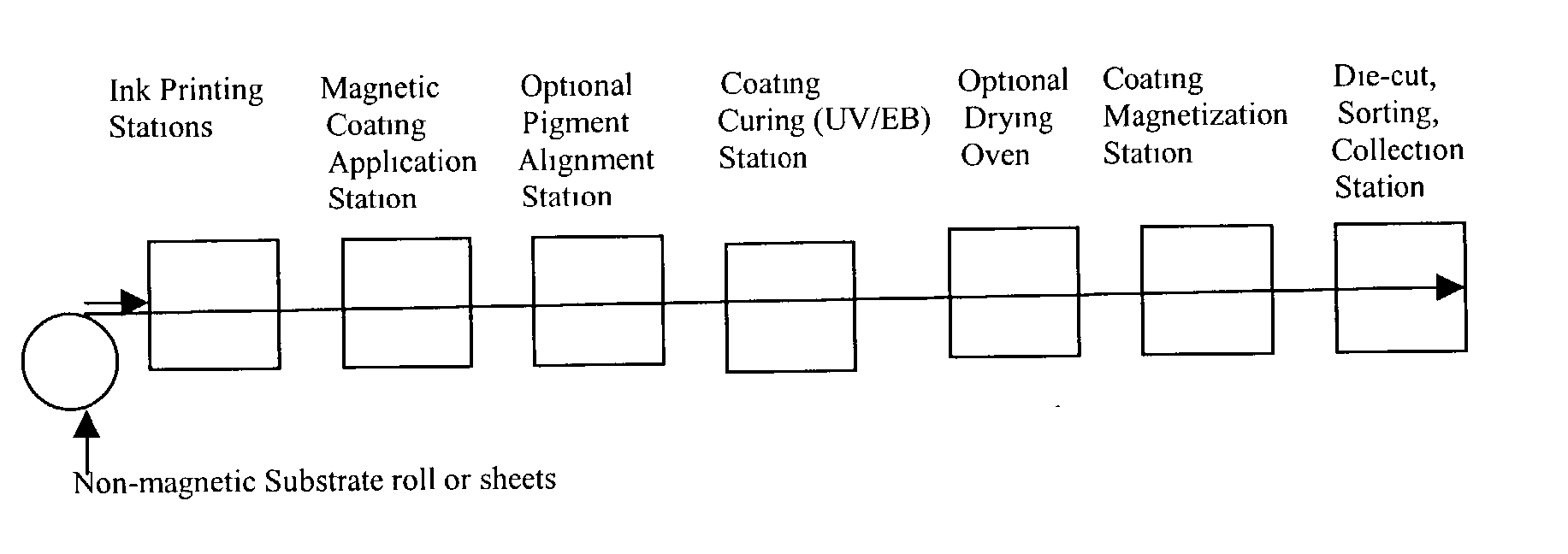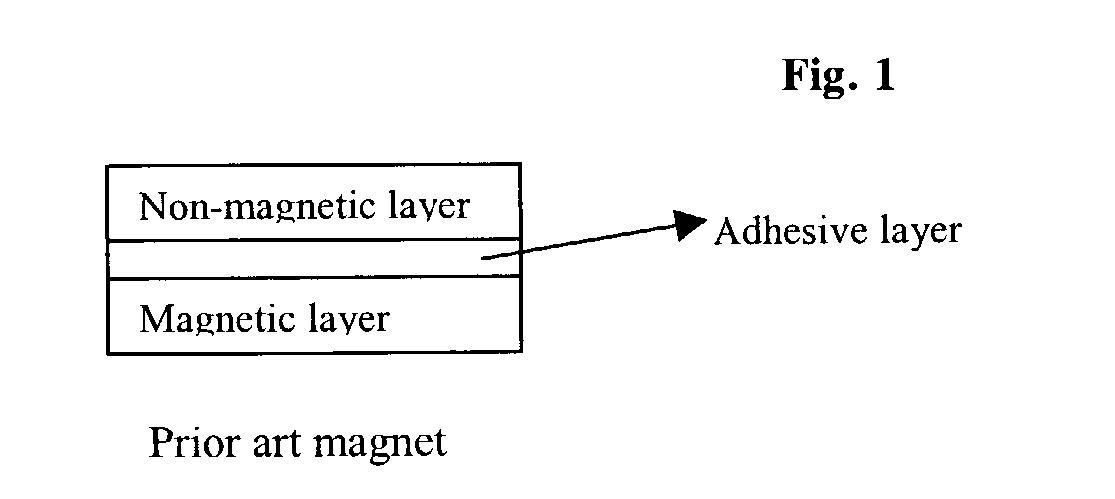UV/EB cured integrated magnets-composition and method of fabrication
a technology of integrated magnets and composite materials, applied in the direction of magnet bodies, inks, transportation and packaging, etc., can solve the problems of inability to meet the immediate design needs of customers, the description process does not address the on-demand shape and size needs, and the size and shape of the design artwork is not suitable for upstream processing waste, etc., to achieve the effect of reducing costs and extending the life of dies
- Summary
- Abstract
- Description
- Claims
- Application Information
AI Technical Summary
Benefits of technology
Problems solved by technology
Method used
Image
Examples
example 1
Preparation of an Integrated Magnet (a Composite Object) of the Present Invention using a Radiation Curable Magnetic Coating Composition
[0094]
4 1,6-hexanediol diacrylate (HDDA) 6.91 wt % PHOTOMER 5429 (polyester acrylate oligomer) 0.97 wt % Amine acrylate monomer 1.45 wt % (adducts of HDDA & diethanolamine) ITX (2-isopropylthioxanthone) 0.10 wt % IRGACURE 907 (from Ciba-Geigy) 0.05 wt % (2-methyl-1-[4-(methylthio)phenyl]-2-morpho-lino propan-1-one) TPO-L (initiator) (Phosphine oxide type from BASF) 0.74 wt % CN966J75 (SartomerCo.) (polyurethane acrylate oligomer) 1.38 wt % MQP-S-9-8 (Magnequench Int., Inc.) 88.40 wt % (isotropic, spherical NdFeB magnetic powder) Total 100.00%
[0095] The binder portion, consisting of the above listed components with the exception of the magnetic particles, was made first by combining the components with mixing. Then, the rare-earth magnetic material, MQP-S-9-8, was mixed in just before use. The resulting radiation curable magnetic composition was appl...
example 2
Preparation of an Integrated Magnet (a Composite Object) of the Present Invention using a Radiation Curable Magnetic Coating Composition
[0097] A radiation curable magnetic composition comprising the following components was prepared according to the process described in Example 1:
6 1,6-hexanediol diacrylate (HDDA) 6.91 wt % PHOTOMER 5429 0.97 wt % Amine acrylate 1.45 wt % (adducts of HDDA & diethanolamine) ITX (2-isopropylthioxanthone) 0.10 wt % IRGACURE 907 0.05 wt % TPO-L (BASF) 0.74 wt % CN966J75 (SartomerCo.) 1.38 wt % MQP-S-11-9 (Magnequench Int., Inc) (isotropic, 88.40 wt % spherical, NdFeB magnetic powder with slightly higher energy output than S-9-8) Total 100.00%
[0098] The resulting radiation curable magnetic composition was then applied on 10 lb C1S paper stock with a wire wound rod #30 to approximately 3 mils thick and cure with both AETEK's unit and Fusion unit and similar cure energy as mentioned in Example 1. The prepared paper magnet samples are then magnetized with t...
example 3
Preparation of an Integrated Magnet (a Composite Object) of the Present Invention using a Radiation Curable Magnetic Coating Composition
[0099] A radiation curable magnetic composition comprising the following components was prepared according to the process described in Example 1:
7 1,6-hexanediol diacrylate (HDDA) 6.91 wt % PHOTOMER 5429 0.97 wt % Amine acrylate 1.45 wt % (adducts of UDDA & diethanolamine) CN966J75 (SartomerCo.) 1.77 wt % Paint additive #57 (Dow Corning) 0.50 wt % MQP-S-9-8 (Magnequench Int., Inc) 88.40 wt % Total 100.00%
[0100] The resulting radiation curable magnetic composition was then applied on 10 lb C1S paper stock with a wire wound rod #30 to approximately 3 mils thick and cure with a lab EB unit from Energy Sciences Inc. (Wilmington, Mass.) with curing dosage of 165 KV and 3 Mrad. The prepared paper magnet samples are then magnetized with the same magnetizer used for Example 1. The samples were adequate for the intended application.
PUM
| Property | Measurement | Unit |
|---|---|---|
| Percent by mass | aaaaa | aaaaa |
| Percent by mass | aaaaa | aaaaa |
| Percent by mass | aaaaa | aaaaa |
Abstract
Description
Claims
Application Information
 Login to View More
Login to View More - R&D
- Intellectual Property
- Life Sciences
- Materials
- Tech Scout
- Unparalleled Data Quality
- Higher Quality Content
- 60% Fewer Hallucinations
Browse by: Latest US Patents, China's latest patents, Technical Efficacy Thesaurus, Application Domain, Technology Topic, Popular Technical Reports.
© 2025 PatSnap. All rights reserved.Legal|Privacy policy|Modern Slavery Act Transparency Statement|Sitemap|About US| Contact US: help@patsnap.com



